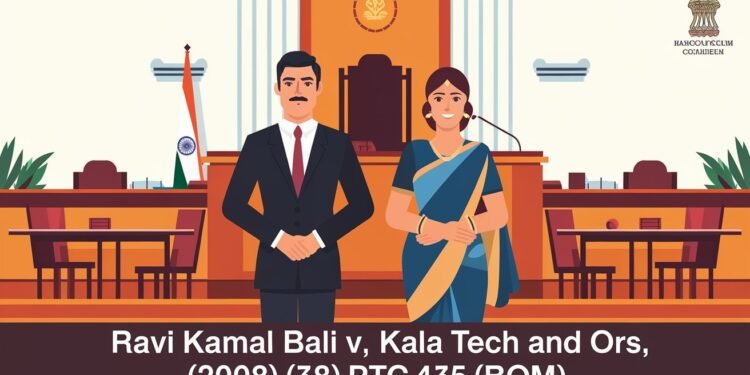ANSHIKA AGARWAL
Introduction
The case of Ravi Kamal Bali vs. Kala Tech and Ors represents a significant legal battle that underscores essential elements of trademark law, concentrating on intellectual property violations and the concept of passing off within the Indian legal framework. The plaintiff, Ravi Kamal Bali, claimed that Kala Tech and the other defendants were utilizing a trademark that closely resembled his own, which was well-established and recognized in the market. He argued that this unauthorized use of a similar trademark was likely to confuse consumers into thinking that the defendants’ products were linked to or endorsed by his business, thereby constituting
trademark infringement and resulting in reputational and financial damage.
The primary legal question at stake was whether the defendants’ use of a similar mark constituted deceptive similarity, creating confusion in the marketplace. To resolve this, the court had to evaluate various factors, including the visual, phonetic, and conceptual similarities between the two marks, the nature of the goods or services associated with each mark, and the potential for consumer confusion. The plaintiff, Ravi Kamal Bali, stressed that his trademark had garnered significant reputation and goodwill, making it essential to safeguard it against any instances of
passing off. This case also explored the doctrine of passing off, which protects unregistered trademarks or trade names from being misappropriated by competitors in a manner that confuses consumers. Passing off aims to safeguard a business’s goodwill rather than focusing solely on registration technicalities. The plaintiff contended that the defendants were taking advantage of the goodwill linked to his brand to market their products, which constituted a misrepresentation likely to mislead the public.
Additionally, the court needed to consider the legal remedies available to the plaintiff in instances of trademark infringement and passing off. Possible remedies such as an injunction to halt further use of the infringing mark, compensation for financial losses sustained, and an accounting of profits gained by the defendants through the misuse of the trademark were addressed. This case highlighted the necessity of protecting intellectual property rights in a competitive environment, where the unauthorized use of a similar or identical mark can have severe commercial repercussions for the rightful owner.
Facts of the Case
The case of Ravi Kamal Bali vs. Kala Tech and others involves important legal matters concerning trademark infringement and passing off. The plaintiff, Ravi Kamal Bali, is a businessman with a well-known brand in the electronics sector, supported by a registered trademark that has been in use for several years and is linked to high-quality electronic products. The defendants, Kala Tech and their associates, are rivals in the same field, and the central issue of the case pertains to their alleged use of a trademark that closely resembles Bali‟s. He argues that this resemblance could mislead consumers regarding the source of the products, resulting in confusion between the two brands. Ravi Kamal Bali stresses that his trademark has gained significant recognition and goodwill, claiming that the defendants’ unauthorized use diminishes his brand’s value and could negatively impact his business reputation. In reaction to the defendants’ actions, he filed a lawsuit seeking an injunction to stop further use of the infringing mark, compensation for financial losses suffered, and an accounting of profits obtained by the defendants. In response, Kala Tech disputed these allegations, claiming that their trademark was not similar enough to cause confusion and that they created their brand independently. During
the proceedings, the court reviewed evidence relating to the visual, phonetic, and conceptual similarities between the trademarks, along with consumer perceptions to evaluate the possibility of confusion. This case underscores key legal principles concerning trademark protection under the Indian Trade Marks Act, showcasing the challenges of defending intellectual property rights and brand identity in a competitive market.
Issues of the Case
The key issues of this case are:
1. The primary issue revolves around whether the defendants’ use of a trademark that is allegedly similar to the plaintiff’s registered trademark constitutes infringement?
2. Whether the trademarks in question are “deceptively similar” which includes evaluating visual, phonetic, and conceptual similarities between the marks to determine the likelihood of consumer confusion?
Rule of Law
In the matter of Ravi Kamal Bali vs. Kala Tech and Ors, various legal statutes and principles were utilized to resolve issues related to trademark infringement and passing off. The fundamental legal framework is the Indian Trade Marks Act, 1999, which oversees the registration, safeguarding, and enforcement of trademarks within India. According to Section 29 of this Act, a registered trademark is deemed infringed if a similar mark is utilized in a way that is likely to mislead or confuse consumers about the origin of goods or services. Moreover, the common law principle of passing off was cited to protect the goodwill linked to the
plaintiff’s unregistered trademark. This principle prevents rivals from falsely portraying their goods or services as those of another enterprise, thus protecting the brand’s reputation. The court also considered the notions of **deceptive similarity**, evaluating visual, phonetic, and conceptual resemblances between the trademarks to assess the potential for confusion among consumers. Additionally, the burden of proof rested on the plaintiff to prove that the defendants’ use of the similar mark was likely to cause confusion, and appropriate legal remedies were sought, including an injunction and compensation for the claimed infringement. Through these laws and legal concepts, the case highlights the significance of protecting intellectual property rights and ensuring fair competition in the marketplace.
Analysis of the Case
The Hon‟ble Court ruled in favor of the plaintiffs, emphasizing that the construction,
functionality, and design of the product must be taken into account. Furthermore, the court noted that the presence or absence of force during the process and the product’s shape represent minor distinctions that cannot be viewed as significant differences. The court referenced Section 54 of the Patents Act, 1970, asserting that “only the patent holder of the main invention has the right to enhance or alter the primary invention and seek a patent for such modifications, as otherwise it would allow others to exploit the main invention.” Therefore, to thwart fraud, the court invoked the Doctrine of Equivalents, concluding that the defendant‟s product infringes on the plaintiff‟s patent. In the case of Warner Jenkinson Co. v. Hilton Davis Chem. Co., the court discussed the Doctrine of Equivalents, stating that when applying the doctrine, the invention cannot be evaluated as a whole. Instead, the invention must be dissected into its individual components, using those specific features to evaluate the accusation against the accused product. However, the Ravi Kamal case did not follow these guidelines and also failed to comply with the All
Elements Rule. There are specific consequences of the Doctrine of Equivalents for the Indian Patent System. First, the Doctrine contrasts with the goals of the Patent Law System. The purpose of Patent Law is to encourage invention, scientific research, new technology, and progress. This Doctrine may hinder inventors from modifying or designing around a patented product since its scope lacks clarification in the ruling.Secondly, it contravenes Section 10 of the Patents Act, 1920 2. In Bayer
Corporation and Ors. v. Cipla, Union of India and Ors., the Court asserted that a patent claim must fully and specifically describe the invention, how it operates, and the method of its execution. The application of this Doctrine would render it impractical to state the product specifications during the application phase, leading to ambiguity when interpretations are not literal. The claims outlining „what it is‟ and „what is not protected‟ may become unclear. This would contradict the Supreme Court’s ruling in Bishwanath Prasad Radhey Shyam v Hindustan Metal Industries, which stated that “the correct approach to interpreting a specification is not to
first read the claim and then consider the full description of the invention but to read the description first to properly understand what it is, what is being claimed, since the patentee cannot claim more than what they intend to patent.”
Conclusion of the Case
The core principle of the Doctrine of Equivalents is to safeguard and maintain the integrity of the patented product. However, its implementation within the Indian legal framework is still uncertain. The author concurs with the reasoning in the judgment of Ravi Kamal Bali v. Kala Tech and Ors., particularly in that minor variations are inadequate to differentiate one product from another and aid in reducing opportunities for fraud in such instances. The author posits that
the Doctrine of Equivalents is still in its early stages in India, which can lead to complications. For example, the Doctrine of Equivalents could interfere with the public’s ability to verify patent claims. Thus, if someone, having reviewed a patent, develops a product that extends beyond the literal interpretation of the claims, they infringe upon the patent under the aforementioned Patents Act 1970, s 10 (5): define the limits of the invention by giving clear and succinct claims and which is based on the matter disclosed in the specification 3 M/s. Bishwananth Prasad RadheyShyam v. Hindustan Metal [1982] AIR 1982 SC 1444 Doctrine. However, the author notes that the ruling did not outline any guidelines, criteria, or tests that should be applied when enforcing the Doctrine of Equivalents in India. Therefore, to effectively implement the Doctrine in India, it is essential to clarify its scope and limitations to genuinely fulfill its intended purpose.
References
-
Ravi Kamal Bali v. Kala Tech and Ors., [2008] (38) PTC 435 (Bom)
The primary case decision, providing a detailed analysis of the court’s reasoning and judgment.
Available via Indian case law databases like SCC Online or Manupatra. -
Indian Trade Marks Act, 1999
The statutory framework governing trademark registration, infringement, and remedies in India.
Full text available at: https://legislative.gov.in -
Patents Act, 1970
Relevant sections such as Section 10(5) and Section 54, governing the specification and rights of patent holders.
Available at: https://legislative.gov.in -
Warner-Jenkinson Co. v. Hilton Davis Chem. Co., 520 U.S. 17 (1997)
U.S. case discussing the Doctrine of Equivalents, referenced for comparative legal analysis.
Available at: https://www.oyez.org -
Bishwanath Prasad Radhey Shyam v. Hindustan Metal Industries, AIR 1982 SC 1444
Landmark Indian judgment on interpreting patent specifications.
Available via SCC Online or Manupatra.



